From safely loading your trailer to choosing the right hitch and tow equipment, there’s much to learn when you’re new to towing an RV. But no choice is more important than determining if you need a weight distribution hitch (WDH).
What is a Weight Distribution Hitch?
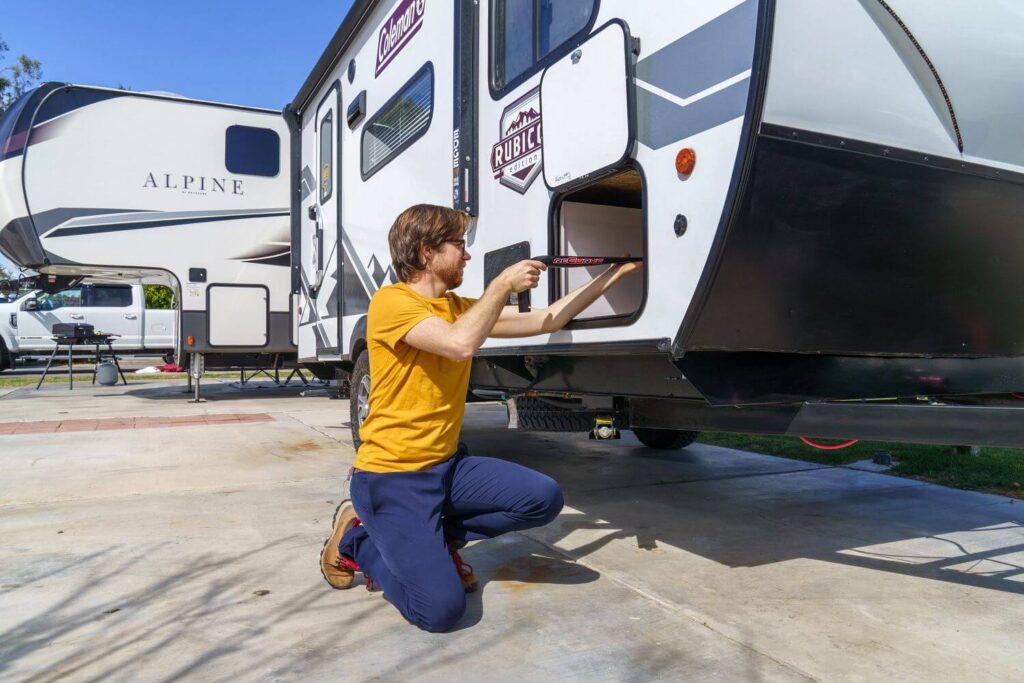
Photo by Camping World
A weight distribution hitch redistributes your trailer’s tongue weight more evenly across all four tires – i.e., both the front and rear axles. Without one, all that weight rests primarily on the rear axle, which increases trailer sway, reduces your fuel economy, and makes your trailer harder to control.
A weight distribution hitch also serves as the connection point between your tow vehicle and your towable camper. The main parts of a weight distribution hitch, and their functions, are as follows:
- The shank inserts into your tow vehicle’s hitch receiver. It gives you a mounting point that can be adjusted up or down to match your vehicle’s height.
- The head provides the connection between the shank and the spring bars.
- Spring bars level your trailer and tow vehicle by evenly distributing weight over both axles.
- Adjustable brackets mount to your trailer frame and provide the mounting point for the spring bars.
Learn how to hitch up weight distribution hitch.
How Does a Weight Distribution Hitch Impact Towing?

Photo by Camping World
The spring bars in a weight distribution hitch essentially serve as a lever. They create pressure that lifts the connection point between your tow vehicle and trailer while lowering the front of your tow vehicle and the back of your trailer.
A weight distribution hitch gives you more level towing, increases control, reduces trailer sway, and improves your tow vehicle’s efficiency.
Do You Really Need a Weight Distribution Hitch?
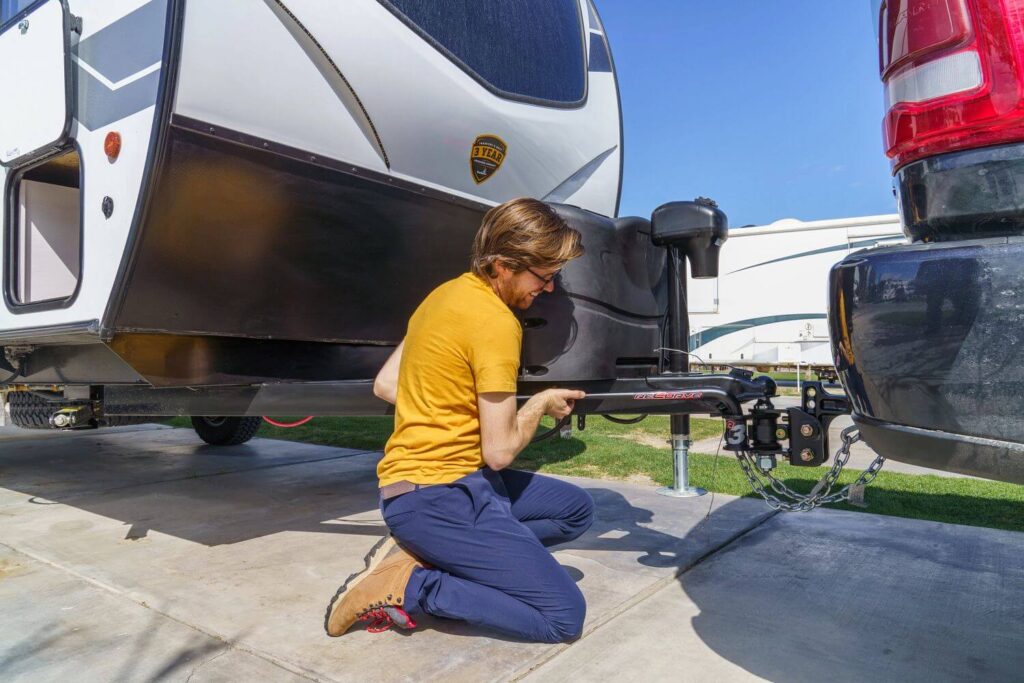
Photo by Camping World
Without a weight distribution hitch, your trailer’s tongue weight rests primarily on your tow vehicle’s rear axle. This often creates a low point at the connection between your vehicle and the camper.
In addition to making you more susceptible to trailer sway, this low point increases your risk of scraping your trailer’s tongue jack on the ground when entering driveways or parking lots. It also causes less efficient towing and reduces the control you feel behind the wheel.
So, can you tow a trailer without a weight distribution hitch? Sure.
Should you? We don’t recommend it.
Learn how to adjust a weight distribution hitch for level, efficient towing.
How to Choose a Weight Distribution Hitch
Weight distribution hitches aren’t compatible with all tow vehicles and trailers. Here’s how to find the right hitch for you:
Hitch Types
There are two main types of weight distribution hitches. Both are named for the shape of their spring bars. Here’s an overview:
Round bar hitches utilize round spring bars that connect to the bottom of the hitch head and then angle back to where they attach to the brackets mounted to your trailer’s frame. They typically offer less ground clearance.
Trunnion bar hitches have square spring bars that attach to the face of the hitch head and extend back parallel to the trailer’s frame before connecting to the mounting brackets. This hitch type generally offers a higher weight capacity and a minimal increase in ground clearance.
Aside from weight capacity and ground clearance, there isn’t a huge difference in performance between these two hitch types. If those two factors aren’t important in your decision, it really comes down to whether you prefer round or square spring bars.
Hitch Rating
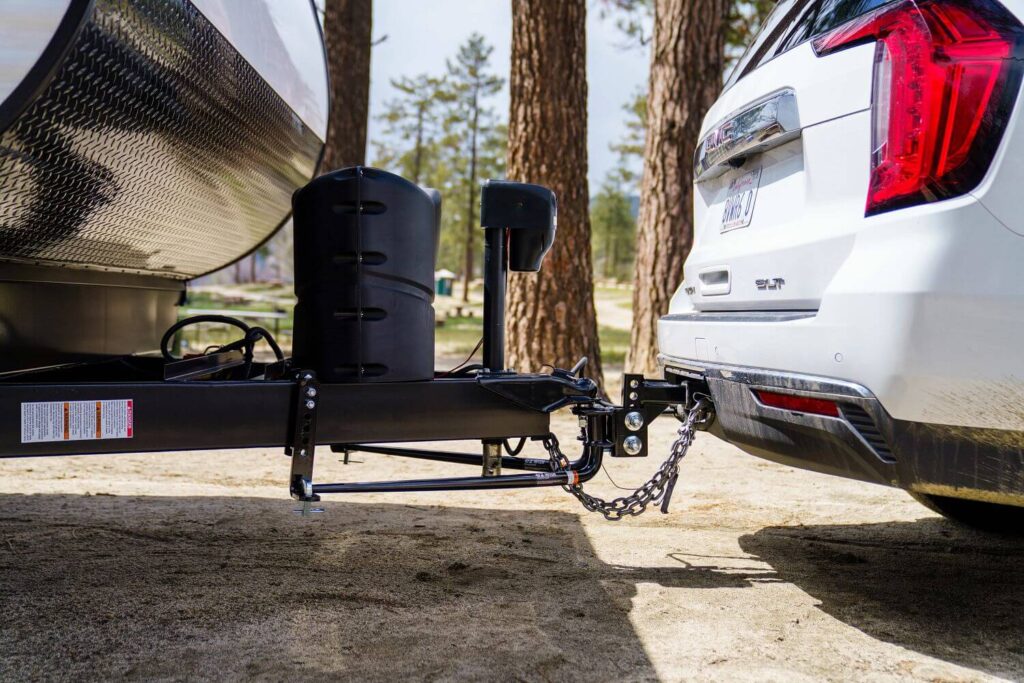
Photo by Camping World
The hitch receiver on your tow vehicle is rated for a specific towing capacity. Here’s a general breakdown:
| Hitch Type | Tow Rating |
| Class I | Up to 2,000 pounds |
| Class II | Up to 3.500 pounds |
| Class III | Up to 5,000 pounds |
| Class IV | Up to 10,000 pounds |
| Class V | Up to 20,000 pounds |
Note that most hitch receivers actually offer two distinct ratings – one for towing with a weight distribution hitch and one for towing without. In most cases, the rating for towing with a weight distribution hitch is slightly higher – usually by a few hundred pounds.
However, installing a weight distribution hitch will not change the towing capacities of any stock component installed on your truck, including the truck itself.
When choosing a weight distribution hitch, ensure it’s compatible with your vehicle manufacturer’s recommendation. You should never exceed the weight capacity of your tow system’s lowest-rated component.
Trailer Tongue Weight
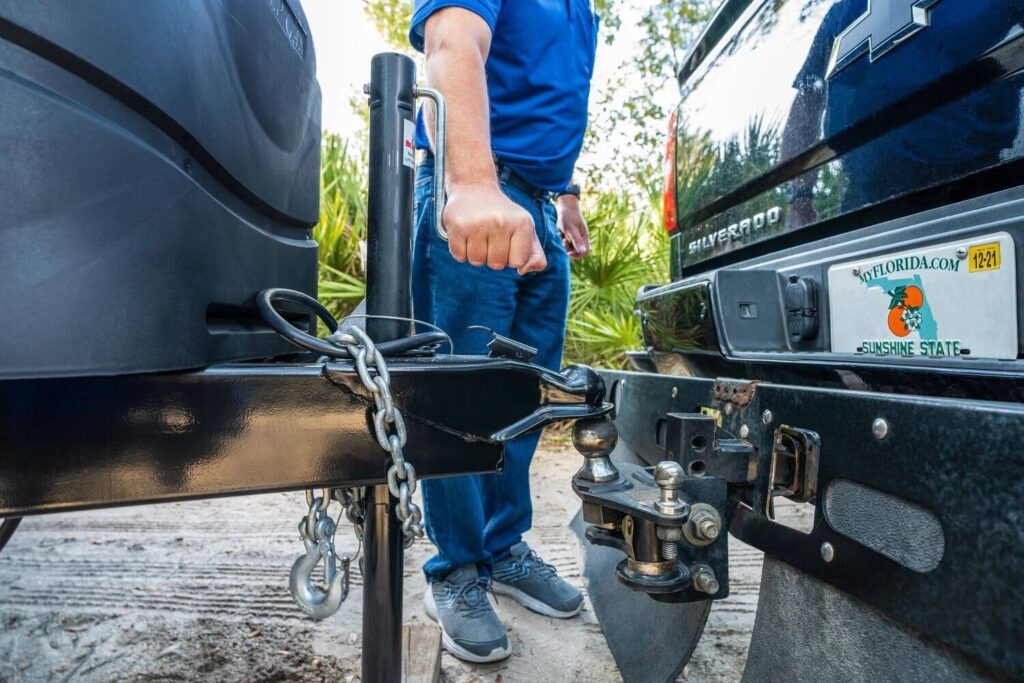
Photo by Camping World
In addition to your vehicle’s towing capacity, pay close attention to your trailer’s tongue weight. This value should be marked on your trailer’s vehicle identification sticker, but it’s also typically about 10% of your trailer’s dry weight.
Once you know your trailer’s tongue weight, you’ll need to add the weight of any cargo loaded into your truck bed. Your total should fall within the acceptable range specified by your weight distribution hitch manufacturer.
The Best Weight Distribution Hitch Models from Camping World
Now that you know you really do need a weight distribution hitch, here are a few of our favorite models:
Reese Pro Round Bar Weight Distribution Hitch
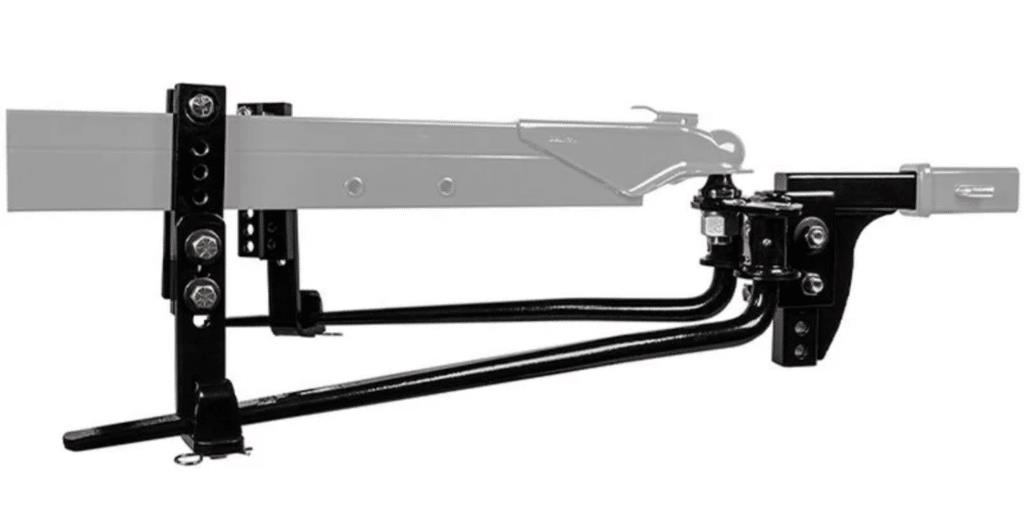
Photo by Camping World
WDH Specs
- Gross Trailer Weight: 8,000 pounds
- Trailer Tongue Weight: 800 pounds
- Hitch Ball Size: 2-5/16”
Reese’s Pro Round Bar WDH includes a deep-drop, 8.5” shank that provides flexibility for larger trucks towing smaller trailers. It also comes with easy-to-install, clamp-on brackets that fit up to 7” trailer frames.
This complete weight distribution package includes the head with a pre-installed hitch ball, tapered spring bars, a deep-drop shank, control brackets, a lift-assist bar, and all installation hardware. All components are powder-coated to provide durability and corrosion resistance.
Shop for this Reese weight distribution hitch at Camping World.
Andersen Hitches Weight Distribution Hitch

Photo by Camping World
WDH Specs
- Gross Trailer Weight: 14,000 pounds
- Trailer Tongue Weight: 1,400 pounds
- Hitch Ball Size: 2-5/16”
Andersen Hitches makes a great WDH for larger travel trailers. The 2” shank has a pre-installed hitch ball that doubles as a standard ball mount for towing without weight distribution.
It also features a variety of bracket sizes (3”, 4”, 5”, and 6”) and works with A-frame, V-frame, and Y-frame travel trailers. Instead of traditional sway bars, the system utilizes interconnected chains to dampen motion and reduce trailer sway and bounce.
Check the price of this Andersen weight distribution hitch.
Camco Elite Weight Distribution Hitch
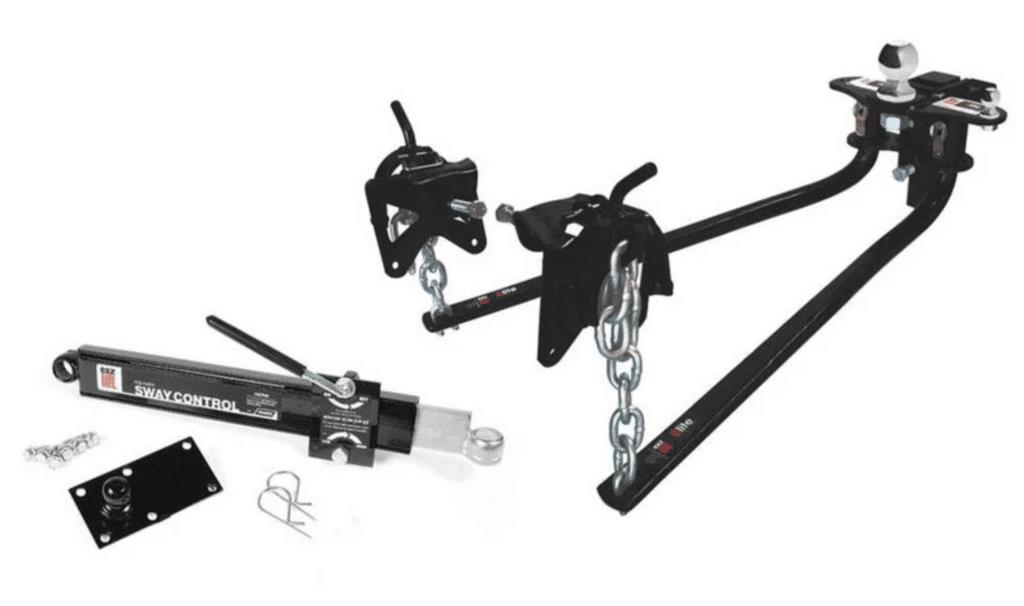
Photo by Camping World
WDH Specs
- Gross Trailer Weight: 10,000 pounds
- Trailer Tongue Weight: 1,000 pounds
- Hitch Ball Size: 2-5/16”
The Camco Elite WDH features several pre-installed components that save you time in the setup process. The hitch ball and sway control ball are torqued to specification in the hitch head as part of the pre-installation.
The system’s U-bolts and chain package are also pre-installed on the spring bars. The WDH package includes all necessary installation hardware so you can set it up and get on the road as quickly and efficiently as possible.
Learn more about this Camco weight distribution hitch.
How to Install a Weight Distribution Hitch
Now that you have your WDH in hand, this video provides step-by-step instructions for installing it properly.
How to Adjust a Weight Distribution Hitch
A weight distribution hitch must be adjusted whenever installed on a new tow vehicle or towable RV. Plus, there are adjustments you can make to level your trailer and enjoy more efficient towing. The video above walks you through the steps to adjust your WDH.
Want to get more out of your RV? Subscribe to the Camping World YouTube channel so you never miss a video.
Now that you know everything you need to know about weight distribution hitches, here are a few more resources to help you tow your trailer safely:
- How to Safely Tow a Travel Trailer
- 17 RV Driving Safety Tips for Beginners
- How to Back Up a Trailer into Your Campsite
What else do you want to know about weight distribution hitches? Let us know in the comments below.
The post Do You Really Need a Weight Distribution Hitch? appeared first on Camping World Blog.
By: Tucker Ballister
Title: Do You Really Need a Weight Distribution Hitch?
Sourced From: blog.campingworld.com/learn-to-rv/do-you-really-need-a-weight-distribution-hitch/
Published Date: Thu, 08 Jun 2023 09:00:00 +0000
---------------------------------------------
Did you miss our previous article...
https://outdoorsnewswire.com/camping/virginias-bethpage-campresort-family-fun-by-the-chesapeake
 CampingSurvivalistHuntingFishingExploringHikingPrivacy PolicyTerms And Conditions
CampingSurvivalistHuntingFishingExploringHikingPrivacy PolicyTerms And Conditions
